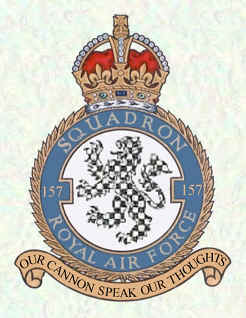
The Armstrong Whitworth A.W.41 Albemarle was a twin-engine transport aircraft developed by the British aircraft manufacturer Armstrong Whitworth and primarily produced by A.W. Hawksley Ltd, a subsidiary of the Gloster Aircraft Company. It was one of many aircraft which entered service with the Royal Air Force (RAF) during the Second World War.
No. 119 Squadron RAF was a squadron of the Royal Air Force, flying with RAF Coastal Command during the Second World War. It was the only RAF unit flying the Short G class and Short C class flying boats.
No. 515 Squadron RAF was a squadron of the Royal Air Force formed during the Second World War. It ushered in Electronic countermeasures (ECM) warfare, jamming enemy radar installations from October 1942 as the only such squadron in the RAF initially. Later in the war 515 Sqn was joined by other squadrons as part of No. 100 Group RAF. The squadron disbanded after VE day, when the need for such a specialised squadron had reduced.
No. 299 Squadron was a Royal Air Force squadron during the Second World War and was part of No. 38 Group.
No. 298 Squadron was a Royal Air Force special operations squadron during the Second World War. Later in that war it changed to the transport role, disbanding after the end of the hostilities.

No. 190 Squadron was a Royal Air Force squadron with a relatively short existence, but a very broad career. It served as a trainer squadron during the first World War and as convoy escort, airborne support and transport squadron during World War II.

No 620 Squadron was a squadron of the Royal Air Force during World War II. During its existence it served as a bomber squadron, airborne forces and a transport squadron.
No. 158 Squadron RAF was a World War I proposed ground attack squadron that did not become operational in time to see action, and a World War II bomber squadron. After World War II had ended in Europe the squadron operated in the transport role until disbandment in December 1945.
No. 512 Squadron was a Second World War Royal Air Force transport squadron.
No. 169 Squadron RAF was a tactical reconnaissance and later a night intruder squadron of the Royal Air Force during World War II.
No. 570 Squadron RAF was a bomber unit active within No. 38 Group RAF as an airborne, bomber support and special operations squadron during World War II.

No. 518 Squadron RAF was a meteorological squadron of the Royal Air Force during the Second World War. The weather observations they collected helped inform Group Captain James Martin Stagg's recommendation to General Dwight D. Eisenhower to delay the launching of the D-Day invasion of Normandy from 5 June to 6 June 1944.
No. 519 Squadron RAF was a meteorological squadron of the Royal Air Force during the Second World War.
No. 575 Squadron RAF was a transport squadron of the Royal Air Force during the Second World War.
No. 502 (Ulster) Squadron was a Royal Auxiliary Air Force squadron that saw service in World War II. It was reformed in September 2013, and is the oldest of all the reserve squadrons, being formed in 1925.
No 295 Squadron RAF was an airborne forces and transport squadron of the Royal Air Force during World War II. It was the first unit to be equipped with the Armstrong Whitworth Albemarle transport and glider tug aircraft.
No. 644 Squadron RAF was a unit in 38 Group of the Royal Air Force during World War II which undertook glider-towing and supply dropping missions as well being employed in the paratroop role.
No. 296 Squadron RAF was an transport squadron of the Royal Air Force during the Second World War. With sister squadrons 295 and 297 it formed 38 Wing, which later expanded to create No. 38 Group RAF.
No. 196 Squadron was a Royal Air Force squadron originally formed as a training unit during World War I. It was active during World War II in Nos. 3, 4 and 38 Group RAF. It served first as a bomber squadron and later as an airborne support and transport unit.

No. 157 Squadron RAF was a Royal Air Force Squadron active as a night fighter unit in the Second World War.





